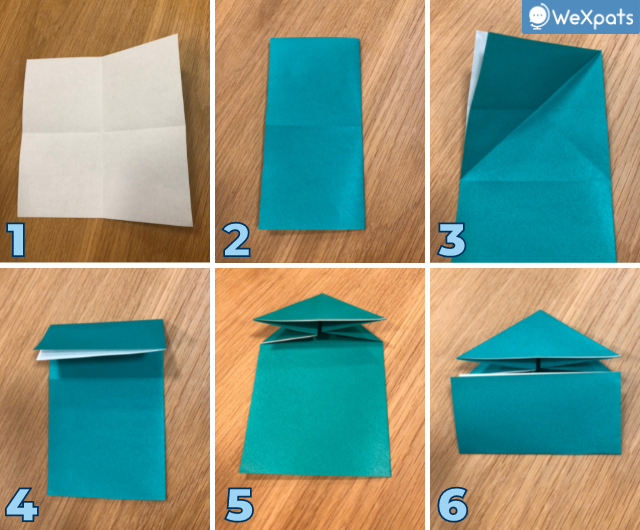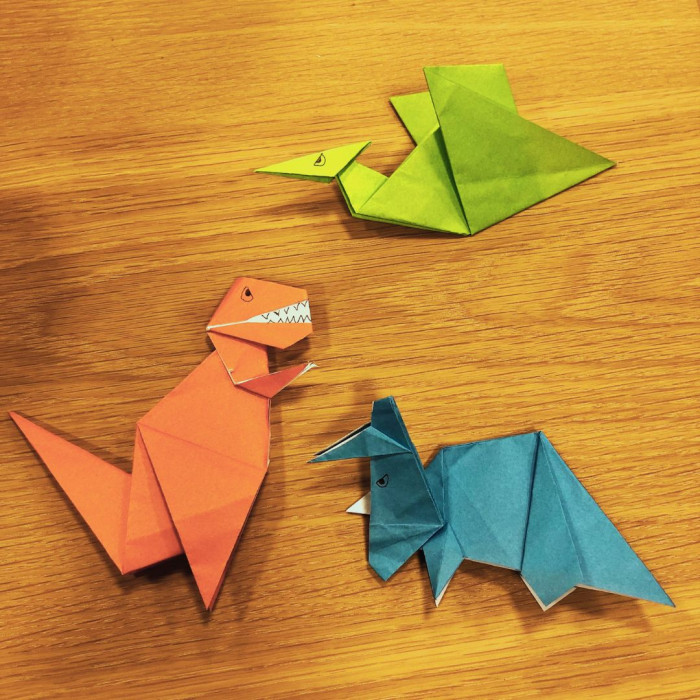Origami is one of Japan’s traditional pastimes and has a long history, when the method of making paper was first introduced and Japanese paper was born. We’ll cover the history of origami, its charm as well as how to fold a few key ones.
Table of Contents
What is Origami?

Origami is a part of Japanese traditional culture, made with washi or Japanese paper. It’s written 折り紙 in Japanese with the parts 折り (ori - to fold) and 紙 (kami - paper). However, it’s also often seen written in hiragana as おりがみ because many Japanese people start making them as children.
A Reflection of Culture and Lifestyle
Origami is said to be born from the fusion of trying to use resources effectively, the culture of folding clothes and futons, and the appreciation of neat sensible straight lines such as squares and rectangles.
Unlike people in various countries overseas, most Japanese people did not practice nomadic pastoralism at the time origami was but instead built houses and made a living by farming and fishing. Since their lifestyles did not involve moving around, they came up with many activities that could be done at home. It is said that origami was born and became popular because of this lifestyle, and it made effective use of used wrapping paper and scrap paper around the house.

A very obvious example of cultural impact is the story of Sasaki Sadako and the 1000 cranes she folded while suffering from the effects of the atomic bombings during World War 2. The paper crane became known around the world as a symbol of peace as well as something that is folded to make wishes as a result.
A Brief History of Origami
It’s said that the papermaking method was introduced to Japan by a person from Goguryeo, a kingdom in what is now Korea. It was then adapted into creating washi, Japanese paper. A luxury product, washi was mainly used for copying Buddhist sutras and creating records, but it gradually came to be used as wrapping paper for offerings to the gods.
The very first origami - literally meaning folding paper - was to make beautiful creases to wrap sacred offerings. It is said to have begun in the Muromachi Period, only done by the religious leaders and the elite who could afford paper. The two types of origami that thrived during this time were ceremonial origami and recreational origami, the latter being the start of modern day origami.

It was only during the Edo Period and the mass production of paper that origami became popular among the common folk, as it became possible to obtain higher quality paper at a low price.
A different origami culture developed in Europe - a famous example being Spain’s “Pajarita” - and it’s said that the current origami was born as a result of combining it and Japanese styles.
Today, origami is accessible to everyone, including overseas, and affordable too! The appeal of origami is that you can use any kind of paper, such as flyers, newspaper, notebook paper, as long as it’s square (with some exceptions). On the other hand, the more you get into origami, you’ll see why experts are particular about the materials and patterns of the paper, as you can create beautiful works of art with them.
Writer's Pick
The Charm of Japanese Origami

There’s several main reasons origami has continued to be loved for hundreds of years.
Just one sheet of paper
Arguably the greatest attraction of origami is that you can express various shapes with just one sheet of paper and play with it. When making things with origami, you basically don’t have to use glue or scissors (although there are some exceptions). Thus, even small children and the elderly can easily make and play with origami.
Portable and Accessible
Like we stated above, origami has become really cheap and accessible to all. You can get colorful origami and even patterned ones at the 100 yen store, not to mention all the other places like bookstores, stationery stores, variety shops, etc. where you can purchase origami. And you can even substitute regular paper for origami.
Great Tool for Communication
Most Japanese people start making origami from a young age. However, it’s difficult for children to figure out how to fold it themselves at first, so adults like parents and nursery school teachers help make it together. It’s a great communication tool, as people can talk about their favorite colors, animals, shapes, etc. as they make origami together.
There’s also a sense of nostalgia for adults when they see origami, especially the more simple and popular designs. When I was making origami for this article (seen below), quite a few people stopped by my desk to express interest or to chat about their memories of making origami as children, their favorite designs back then, etc.
Develops Concentration, Dexterity
Making origami stimulates the brain, as you have to not only concentrate on making clean folds - otherwise the end result will not be as neat - but you have to refer to the directions and figure out how to make it yourself. You will also naturally acquire patience and an eye for details, as making things quickly is not the goal in origami, but to make them neatly, correctly and beautifully. In addition, making origami works helps activate your working memory which stores temporary memories, improves spatial cognition and dexterity. Thus it’s suggested as a way to prevent dementia, and used during rehabilitation.
Beauty and Creativity
Origami may seem quite simple (especially the basic designs), but when done neatly, it looks very nice. People also like to use chiyogami - origami paper with patterns, often traditional - to make the origami, adding an extra layer of beauty.
Origami is also developed to reflect things we see in real life - such as seasons, holidays, popular characters in fiction, etc. It’s also why new origami books and magazines are published annually, and origami paper manufactured every year. And people continue to make more and more challenging and detailed designs to this day.
Check out Ikuno Riku’s Incredible Origami Designs for example. This level of creativity is not easily imitated.
How to Make Popular Origami!
Here are 3 popular origami works that many Japanese learn how to fold, and how to fold them.
Crane

The paper crane is not just the most famous origami work, but it’s also a symbol of Japan and peace.
Here’s how to make it.

1. Start with a sheet of origami paper.
2. Make pre-creases to make folding easier later. Fold it in half, and then half again, and open.
3. Fold opposite corners together to make a triangle.
4. Fold in half one more time to make a smaller triangle.
5. Open one triangle and flatten towards one corner (the pre-creases should make this easier).
6. Do the same on the opposite side.

7. Fold the left and right flap towards the middle and the top corner down over them. These are also pre-creases for the next part.
8. Open up the top piece upwards.
9. Flatten everything carefully into a diamond shape.
10. Do the same on the other side.
11. Folded the left and right flap towards the middle.
12. Do the same on the other side.

13. Take the right piece from the bottom and fold it up into the right crease. Do the same to the left piece.
14. If you flatten the two pieces down, you can see they form the head and tail.
15. Fold down one side carefully to make a head. Last, if you open the wings up, it should be able to balance on its own.
More complex designs for the paper crane have been created over the years, but the one above is the most basic one.
Shuriken

A popular weapon used by ninjas also known as a throwing star. This design is popular because it uses two colors, looks nice, and you can decorate or play with them.

1. Get two pieces of origami paper.
2. Fold them in half to make a middle crease.
3. Fold the left and right sides towards the middle crease.
4. Fold the right side over to the left (the initial middle crease should now be on the right).
5. Fold down the corners to form triangles. Note that the folds will be opposite on the two colors.
6. For the left piece (red), fold the bottom corner up towards the left. The top corner will be folded down towards the right. Do the opposite folds for the right piece (purple).

7. Flip the left piece (red) over. The right piece (purple) should stay as is except twist 90 degrees.
8. Place the purple piece on top of the red piece.
9. Tuck the corners of the red piece into the “pockets” of the purple piece.
10. Flip over.
11. Tuck the corners of the purple piece into the “pockets” of the red piece. Once snug, it’s done!
Frog

This frog is super fun because if done correctly, you can actually make it hop! Kids have fun seeing who can launch theirs the furthest!

1. Make pre-creases by folding in half, then half again, then open.
2. Fold the right side to the left.
3. Time for more pre-creases! Fold the top left corner down to the halfway crease, then open. Do the same with the top right corner.
4. Fold the top down to the halfway crease.
5. This part is tricky. Using the pre-creases, fold in the right and left corners into the sides so they form a triangle.
6. Fold up the bottom half to the middle crease.

7. Fold the left and right sides towards the middle. This means the back side of the triangle at the top will also be tucked in along with the rest. (Do this carefully so it doesn’t rip.)
8. Fold the bottom part up to the base of the triangle.
9. Another tricky part. Pull on the inner corners of the bottom flap and pull them out to create pointed pieces.
10. Fold up the legs for both the bottom half and top half.
11. To create the spring, fold up the bottom half, then fold back just half of it.
If you use your finger to press down on the back of the frog, it should leap forwards or even flip when you release.
How to Make Other Popular Examples
There are of course countless other examples of origami works. Here are a couple more popular ones that many children learn how to make and play with, as well as one that went viral on social media more recently.
Camera

Balloon

Tulips

Weightlifter
This one went viral on Twitter and we think it's hilarious! If you change the bottom part a little, you can make a genie instead!
マッチョ折紙の折り方です。みなさんもマッチョを折りましょう。※一部ハサミを使います。 #折り紙 #オリジナル pic.twitter.com/lFT3ABpyxs
— 嘯(しゃお) (@xiao_signo028) January 6, 2023
And once you get quite good, you can move on to slightly more challenging designs!

To Close
Origami has been loved for so long by people of all ages, and we hope this article helped to explain why and also ways you can enjoy it. Whether done alone or with others, it’s a fun activity and you can end up with some pretty things to display or play with!




































